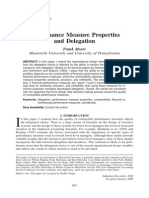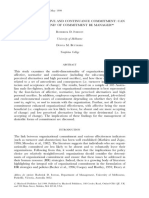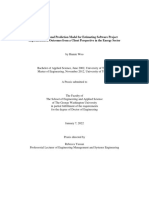The Juxtaposition of Social Surveillance Controlswith Traditional Organizational DesignComponents*
SALLY K. WIDENER,
Rice UniversityMARGARET B.SHACKELL, Cornell University - .
;^; ELIZABETH A. DEMERS,
INSEAD
1 Introduction
Theoretical and empirical accounting, economics, and management literatureshave long recognized both the importance of, and interdependencies among, the threeprimary components of organizational architecture: incentive compensation, the dele-gation of decision rights, and performance measurement (e.g., see Abernethy,Bouwens, and Van Lent 2004).' As Roberts (2004, 36) states, The substitutionand complementarity relations among choice variables give structure to the problemof organizational design. Our study directly addresses this notion of complementsand substitutes by empirically examining the relations among the relatively contem-porary concept of social surveillance controls and the firm's traditional architecturaldesign choices. Social surveillance controls consist of vertical surveillance mechan-
isms,
which involve monitoring from the top level of the organization, as well ashorizontal surveillance controls, such as teams that include peer monitoring. Ourstudy is motivated by the fact that, although surveillance controls are known to playan integral role within organizations (Sewell 1998; Devine, Clayton, Phillips,Dunford, and Melner 1999; Engel, Gordon, and Hayes 2002), their role within theoverall design of the firm's architecture is not well understood.2 We hypothesizethat incentives (percentage of annual bonus and stock option compensation), perform-ance measures (output measures), and the allocation of decision rights (delegation
* Accepted by Michel Magnan. The authors appreciate helpful discussions with Mark Bolino. BobBozeman. Kevin Bradford, Glen Dowell, Jae Heme, and Dave Regn related to this project. Valuableresearch assistance was provided by Michael France. Tricia de Groot, Hang Li. Luke Ratke.Garett Skiba, Jessica Xu, and Adrian Yu. We also thank Christopher Adams. Shannon Anderson,Jim Hesford. Denise Jones. Jeff Miller. Neale O'Connor. Oliver Pfeil. Michael Raith, Dahlia Rob-inson. Lisa Sedor. Jim Seida, Frank Selto, Sandra Vera-Munoz. Wanda Wallace, Joe Weber, JenyZimmerman, and workshop participants at the Ohio State University, University of Rochester,University of Notre Dame. Texas A&M University, University of Melbourne, the Frank BattenYoung Scholars Forum at the College of William and Mary, the EIASM Third Annual Directionsin Management Accounting Conference, and the American Accounting Association annual meetingsin Hawaii, for comments on earlier versions of
t is
paper. We are grateful to two anonymous refereesand the editor, Michel Magnan, whose comments have substantially improved our manuscript.The financial support of CIMA is gratefully acknowledged. All errors are the sole responsibilityof the authors.
Contemporary Accounting Research
Vol. 25 No. 2 (Summer 2008) pp. 605-38 © CAAA. doi:10.1506/car.25.2.11

606 Contemporary Accounting Researchof hroad decision-making powers) are complementary choices. We also hypothesizethat horizontal surveillance will complement the allocation of decision rights(Brickley, Smith, and Zimmerman 2003a), while the remaining relations amongeach of the vertical and horizontal surveillance controls and each of the traditionalorganizational design components will be substitutes for one another (Arya, Felling-ham, and Glover 1997; Engel et al. 2002). Our findings are broadly consistent withthese predictions, and we thus make a contribution to both the organizationaldesign and surveillance control literatures by documenting the complementary andsubstitute roles of traditional aspects of organizational architecture together withthe horizontal and vertical surveillance controls.Our study consists of data from field-based and telephone survey interviews of53 sales/market ing vice-presidents (VPs) of business-to-consumer (B2C) Internetfirms. Our results suggest that vertical surveillance is a substitute for delegation inthat firms with higher levels of vertical monitoring allocate fewer decision rightsthroughout the sales and marketing department. Our finding that firms with higherlevels of team usage use less incentive compensation to motivate and align behav-ior suggests that horizontal surveillance in the form of peer pressure is a substitutefor incentives. Together, these findings suggest that vertical and horizontal surveil-lance controls replace the more traditional aspects of organizational design.Finally, we find that the allocation of decision rights is positively associated withthe use of incentives, and that the use. of incetitives and reliance on output mea-sures are complements. • •; • .. •;The implication of our findings for managers and boards who are responsiblefor a firm s organizational design is that there are complements and substitutesavailable in the choice of organizational design components. Our results suggestthat in relatively small entrepreneurial firms sales and marketing departments,principals use incentives to offset the loss of control that arises from the allocationof decision rights, and they rely on output measures to evaluate employee behavior.Furthermore, there is some evidence that the relation between performance mea-sures and incentives is a complementary one in our setting, suggesting that outputmeasures are viewed as relatively accurate and precise in this context and thusmanagers can use them to reduce the cost of incentive compensation. The implica-tions of our study are relevant to organizational design decisions at the departmentallevel or within smaller business units.The balance of this paper is organized as follows. Section 2 develops ourhypotheses and presents the theory underlying the choice of variables. Section 3describes the sample and explains the research method, as well as defines our empir-ical proxies. Section 4 presents our model specification and discusses our empiricalresults, along with implications. Section 5 presents our conclusion and limitations.
2
Theory and hypothesis development
We begin this section by presenting a general hypothesis of the interdependenciesamong the three traditional components of organizational design (Jensen andMeckling 1976; Milgrom and Roberts 1992; Brickley, Smith, and Zimmerman2003b). We then develop the specific predictions regarding the relations among
CA
Vol. 25 No. 2 (Summer 2008)
Social Surveillance Controls atid Organizational Design Components 607the traditional components. Next, we integrate our predictions regarding the juxta-position of surveillance controls on each of the traditional organizational designcomponents.
Interdependencies among organizational design components
Economic theory maintains that complementarity and substitution relations existamong organizational design components in meaningful patterns (Roberts 2004).We draw on Jensen and Meckling 1976 to argue that that the relations among theallocation of decision rights, the use of output measures for evaluation, and the useof incentive compensation are interdependent (see also, among others, Jensen andMeckling 1976; Melumad, Mookherjce, and Reichelstein 1992; Milgrom and Rob-erts 1995; Poitevin 2000; Athey and Roberts 2001; Roberts 2004).^ We thenhypothesize the following: ,, •• ''-u-^u t '
->•
HYPOTHESIS
1.
Incentive compensation, delegation of decision rights, andperformance measurement are interdependent.
,..p ; ;, • ,, •Consistent with the general usage of the terms in the economics literature, wedefine activities to be
complements
if doing (more of) any one of them increasesthe retums to doing (more of) others, and activities are said to interact as
substi-tutes
if the marginal benefit of each activity decreases in the level of the otheractivity. In our empirical tests, we implicitly assume that our sample firms' organi-zational design decisions are rational (but not necessarily optimal), and interpretpositive associations among organizational design choices as evidence of comple-mentarity and negative associations as evidence of substitutional relationships. Inthe following subsections, we develop the specific theoretical relations amongthese components in more depth and specify our directional predictions.
Incentive compensation and performance measures
Agency theory suggests that principals must design incentive-compatible contractsin order to induce their agents to undertake the desired actions (Kreps 1990).Incentive compensation is costly to firms because it imposes risk on risk-averseemployees (Milgrom and Roberts 1992). In order to manage this costly proposition,it is necessary for firms to rely on performance measures since an agent's behavioris often unobservable (Baker 1992; Feltham and Xie 1994). Incentive-related costscan be better managed if more accurate and precise performance measures areavailable for use in the compensation contract (Milgrom and Roberts 1992). Inshort, better perfonnance measures should lead to stronger incentives, while thereverse is also true; a higher use of incentive compensation should be associatedwith a higher use of output measures
PM),
since relying on more precise measuresreduces the costs of the incentive risk (Roberts 2004). It is efficient for firms toinvest in improving the precision of their performance measurement system to theextent that they reduce the costs ofthe risk associated with their incentive system.Accordingly, we expect that there is a complementarity between incentives andperformance measures, and thus we expect the structural relation to be positive.'*
R
Vol.
25 No. 2 (Summer 2008)
608 Contemporary Accounting Research , ^ '-• • AM*
.*.:_.,)?:
Incentive compensation and delegation
•,• ,;.It is well accepted that delegation and the use of incentive compensation
{/NCENT
are a jointly determined organizational design problem (Melumad andRichelstein 1987; Melumad et al. 1992; Baiman and Rojan 1995; Bushman,Indeijikaisn. and Penne 20(K)). In a value-maximizing firm, decision rights are collo-cated with knowledge, subject to the constraint that the benefits of this collocationexceed the combined costs of knowledge transfer and control (Hayek 1945; Jensenand Meckling 1976; Christie. Joyce, and Watts 2003). When knowledge transfercosts are high, such as in rapidly evolving firms, more decision rights are allocatedto lower levels in the organization that have closer access to the informationneeded for effective decision making. Although this delegation may reduce thecost of information gathering and transfer, it will increase the demand for control— for example, in the form of performance-based compensation for the subordi-nates to whom decision rights have been transferred. Poitevin (2000) provides aseries of analytical models that demonstrate the trade-offs that exist betweencommunication costs and control losses and that result in decentralization beingpreferred to centralization. In sum. the theoretical literature suggests that incen-tives and delegation are complements (Roberts 2004). Empirical results partiallysupport the theory. Nagar (2002) finds that branch managers receive higher levelsof incentive compensation when they possess more decision-making responsibil-ity, while O'Connor, Deng, and Luo (2006) find that divisional managers eamhigher levels of merit-based incentive compensation when they are allocatedhigher levels of decision rights. On the basis of prior literature, we expect that thestructural relation between incentives and delegation will be positive.
Delegation and petformance measures
From the above two sections, it follows that delegation and perfonnance measuresmust also be interdependent. Managers delegate tasks depending on whether thereare readily understood and informative measures available to control and monitor thedelegation (Grossman and Hart 1986; Melumad, Mookherfee. and Reichelstein1995). More tasks can be delegated when the measures are more reliable (Holm-strom and Milgrom 1991). Narayanan and Davila (1998) analytically demonstratethe complementarity structure between performance measurement and delegation.They show that an accounting performance measure can be used to both evaluateperfonnance and facilitate decision making when appropriate decision rights aredelegated to the relevant agents. Villadsen (1995, 316), using an analytical model,concludes that delegating decision authority to a better informed manager is effi-cient provided he is held accountable for his decisions .-'' Milgrom and Roberts(1992) argue that if divisional summary measures are lacking, then centralizationis a control option. Prendergast (2002) analytically demonstrates that more delega-tion should be accompanied by more aggregate measures of performance, sincethis provides principals information about more ofthe delegated activities and alsoallows agents more discretion in their choice of actions. Zhang (2003) also analyti-cally demonstrates that an aggregate measure such as revenue is useful in measuringperformance when an employee is assigned multiple complementary tasks. There
R
Vol. 25 No. 2 (Summer 2008)




























































































